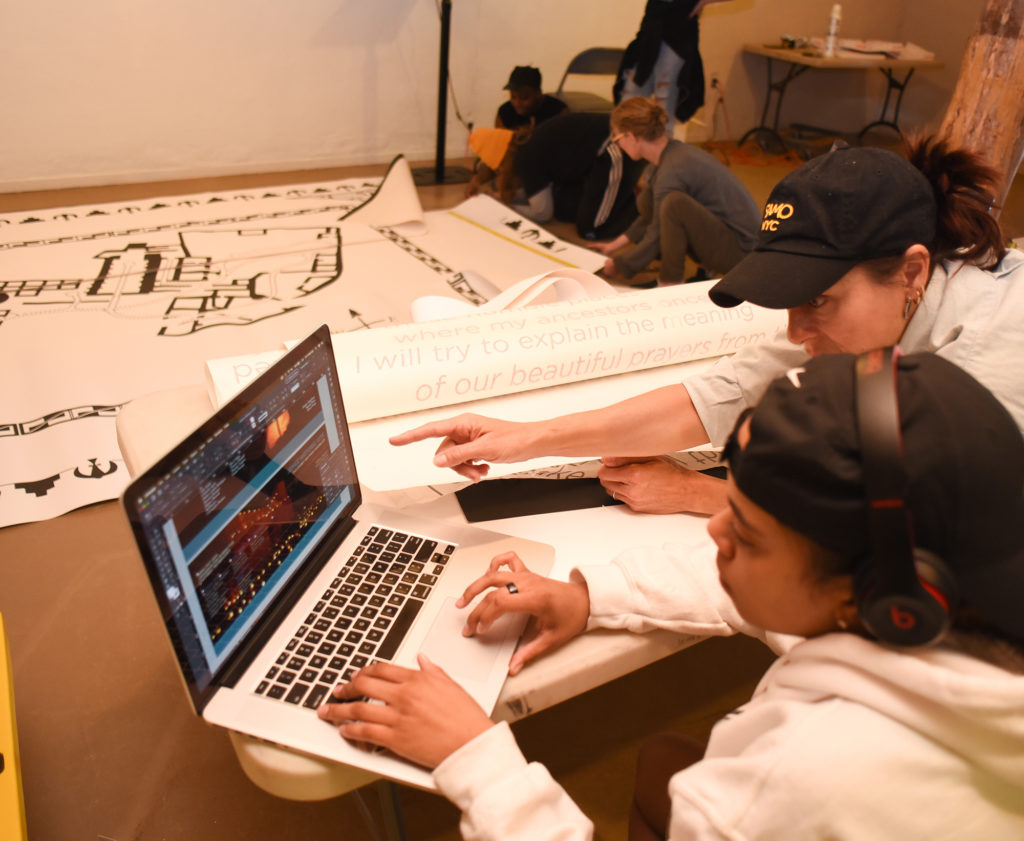
Las Vegas, N.M. – Fifteen media arts students in New Mexico Highlands University’s one-of-a-kind Program for Interactive Cultural Technology (PICT) have redesigned the Jemez Historic Site visitor center with immersive media for an in-depth look at the region’s cultural history. The new exhibit will open to the public May 18.
The PICT students created floor-to-ceiling video projections of historic images and oral histories; developed exhibit panels; chose a new color palette for the site; designed a new trail guide and an activity book; added two interactive touch-screen computer tablets that focus on artifacts and a Jemez event called “Light Among the Ruins;” redesigned two bathrooms highlighting the Jemez night sky and the volcanic features in the nearby Valles Caldera Wilderness Preserve; and installed an engraved wood floor featuring a map of the site drawn by the site staff, who are all Jemez tribal members. The Las Vegas company Old Wood carved the floor.
Senior Becca Sharp and graduate student Terence García were the project managers who oversaw the student design, multimedia and video teams.
“The most important part of the project was to give the Jemez community permanent new exhibits that will forever honor the history of the Jemez Pueblo,” Sharp said. “We want visitors to the site to experience the beautiful culture and community in Jemez while also recognizing the hardship and struggles they have endured.”
García said: “One of the main goals of the video and other images in the exhibit is to convey that the Jemez culture is still thriving today. The Jemez culture was not lost in time and has a bright future. It was an honor to have the responsibility of being a project manager for this exhibit.”
“The media arts students took a dated and static exhibit from the 1970s and transformed it into a stunning dynamic experience,” said Ethan Ortega, instructional coordinator and supervisory archaeologist at the site.
“The students created a very unique and innovative exhibit that is unlike any other historic site in the Southwest.”
Ortega said the historic village of Giusewa was built in the narrow San Diego Canyon by the ancestors of the present-day people of Jemez, or Walatowa, Pueblo. The name Giusewa refers to the natural springs in the area. The site is also considered a National Historic Landmark.
“In the 17th century, the Spanish established a Catholic mission at the village. The mission was short-lived, and, in time, the people were forced to leave the ancient village of Giusewa and moved to the current location of the Jemez Pueblo,” Ortega said.
Ortega said the students used oral histories and texts written by Jemez tribal members to create the new components for the visitor center. “One of the most exciting elements of the new exhibit is that it’s also derived from designs that Jemez tribal members created. In addition, it’s very important that the digital exhibit the students created will allow the Jemez Historic Site to share new archaeological research with the public.”
Media arts professors Miriam Langer, Mariah Fox Hausman and Eli Gonzalez co-taught the PICT class spring semester.
“With Highlands’ Program for Interactive Cultural Technology, the students are trained to become experts in cultural interpretation and presentation,” said Langer, who chairs the Department of Media Arts and Technology.
Fox Hausman said, “The students’ exhibit connects the landscape and cultural history of the Jemez people in a robust way.”
“The large format video projection is an immersive alternative to conventional storytelling,” Gonzales said.
The Jemez Historic Site, known as one of the most beautiful prehistoric and historic sites in the Southwest, includes the stone ruins of a 500-year-old village and the San José church, which dates to 1622. It is located at Jemez Springs and State Highway 4, a short drive from Albuquerque and Bernalillo.
